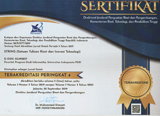Sistem Informasi ERP (Enterprise Resources Planning) untuk Mendukung Fungsi Bisnis pada PT. Cipta Mandiri Elektrindo
(1) Universitas Bina Sarana Informatika
(2) STMIK Nusa Mandiri
(*) Corresponding Author
Abstract
The development of information technology that has an impact on behavior and culture in business can be so easy and fast. It becomes a challenge for a company to be able to balance and play an active role in order to compete in the business world. In this study researchers tried to model the ERP concept as the basic foundation of integrated business processes. The usecase and squares diagrams are used as business process modeling. the implementation of software development involving modules, views and controllers reinforced with the LRS design is used to display database connectivity. The basis path test gives results with value 3 is an use of algorithms in low risk categories. Validation testing with valid results becomes a response with fulfilled functional requirements. While the results of testing non-functional requirements related to usability through the calculation of the T test where t hit = 4.580> t 0.05, 9 = 2.265, indicating that the system application is acceptable and influences the efficiency and effectiveness of work.
Keywords
Full Text:
PDFReferences
C. Hardjono, F. Informatika, and U. Telkom, “Perancangan Dan Implementasi Erp ( Enterprise Resource Planning ) Modul Sales and Warehouse Management Pada Cv . Brada,” eProceedings Eng., vol. 4, no. 3, pp. 4983–4993, 2017.
I. Gautama, “Relationship Marketing Dan Pemanfaatan Teknologi Informasi Dalam Customer Relationship Management Untuk,” vol. 2005, no. Snati, 2005.
S. S. Utami, H. Susilo, and Riyadi, “ANALISIS PENERAPAN ENTERPRISE RESOURCE PLANNING (ERP) (Studi pada PT Domusindo Perdana),” J. Adm. Bisnis, vol. 33, no. 1, pp. 165–170, 2016.
M. Khoiron, “Rancangan Model Sistem ERP pada Perusahaan Sektor Jasa Keuangan,” J. Inform., vol. 11, no. 1, p. 46, 2017.
S. Anardani, A. R. Putera, E. R. Planning, V. Chain, and S. Informasi, “Analisa Perancangan Enterprise Resource Planning Pada Cv . Mitra Internusa Jaya Surabaya,” vol. 11, no. 2, pp. 80–85, 2017.
R. Al Aziz, F. Amalia, and A. Hendra Brata, “Pembangunan Sistem Enterprise Resource Planning pada Griya Laundry,” J. Pengemb. Teknol. Inf. dan Ilmu Komput. Univ. Brawijaya, vol. 2, no. 6, pp. 2278–2285, 2018.
F. Tanzil, “Waterfall model,” web, 2019. [Online]. Available: http://socs.binus.ac.id/2018/12/21/waterfall-model/.
S. Wibisono, “Enterprise Resource Planning (ERP) Solusi Sistem Informasi Terintegrasi,” J. Teknol. Inf. Din., vol. x, no. 3, pp. 150–159, 2005.
A. Rukajat, Pendekatan Penelitian kuantitatif, Pertama. Yogyakarta: Deepublish, 2018.
J. Simarmata, Rekayasa Perangkat Lunak. Yogyakarta: Andi Offset, 2010.
H. Purwanto, “Laporan Akhir,” Jakarta, 2019.
Meiliana, “Software Testing :Cyclometic Complexity,” Web, 2016. [Online]. Available: http://socs.binus.ac.id/2016/12/29/software-testing-perhitungan-cyclomatic-complexity/.
M. Cabe, “Cyclomatic Complexity (McCabe) Metric,” Gmetrix, 2015. [Online]. Available: http://gmetrics.sourceforge.net/gmetrics-CyclomaticComplexityMetric.html.
DOI: http://dx.doi.org/10.30998/string.v4i1.3759
Refbacks
- There are currently no refbacks.
Copyright (c) 2019 heru purwanto

This work is licensed under a Creative Commons Attribution 4.0 International License.
STRING (Satuan Tulisan Riset dan Inovasi Teknologi) indexed by:

Ciptaan disebarluaskan di bawah Lisensi Creative Commons Atribusi 4.0 Internasional.
View My Stats


 Sertifikat Akreditasi
Sertifikat Akreditasi
















